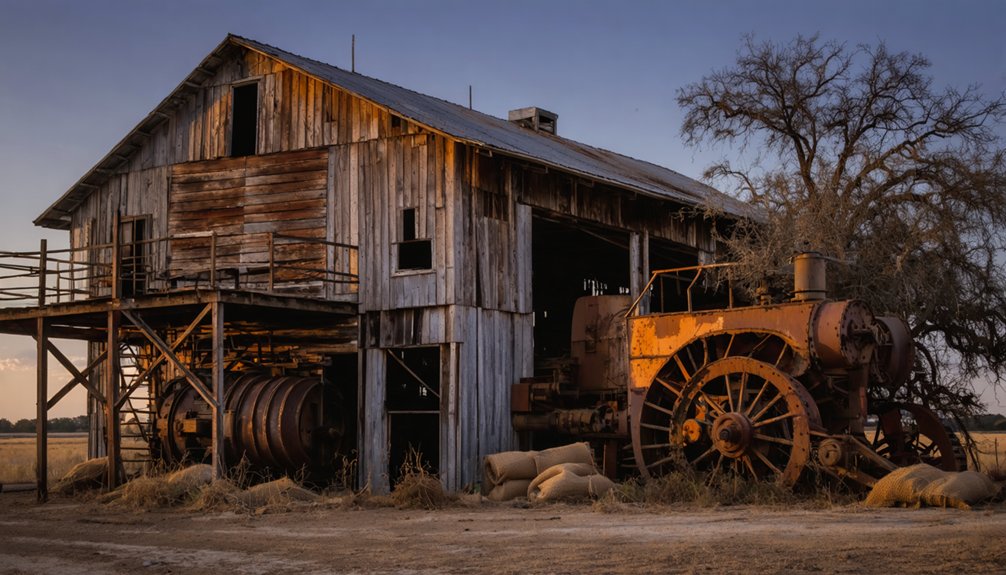You’ll discover Emma’s rise and fall in central Crosby County, Texas, where merchants R.L. Stringfellow and H.E. Hume founded this frontier town in 1891. At its peak in 1910, Emma thrived with 800 residents, a courthouse, bank, and bustling main street. When the railroad bypassed the town by five miles, residents and businesses relocated to nearby Crosbyton. Today, only a cemetery and historical marker hint at Emma’s fascinating change from county seat to ghost town.
Key Takeaways
- Emma was founded in 1891 and served as Crosby County’s seat until 1910, reaching a peak population of 800 residents.
- The town’s decline began when the railroad bypassed Emma by five miles, leading residents to relocate to nearby Crosbyton.
- Emma lost its county seat status to Crosbyton in 1910, resulting in the dismantling of its courthouse and closure of businesses.
- Today, only a cemetery containing graves of Civil War veterans and early settlers remains at the former town site.
- A historical marker placed in 1968 commemorates the location where Emma once stood as a thriving commercial center.
The Birth of a Texas Frontier Town
While frontier towns often sprang up gradually across Texas, Emma’s establishment in 1891 was a deliberate and calculated venture by merchants R.L. Stringfellow and H.E. Hume. The founders’ vision centered on creating a new hub in central Crosby County, strategically positioned to serve the region better than the existing town of Estacado.
You’ll find the roots of Emma’s story in the fall of 1890, when Stringfellow and Hume acquired the land and named it after Emma Savior, who’d later become Stringfellow’s wife.
Their community planning was swift and purposeful – they’d secured a post office by 1890 and laid out the town site in 1891. The careful plotting of streets and designation of spaces for churches, schools, and businesses reflected their ambition to build a lasting settlement. Their efforts proved successful as Emma reached a peak of 800 residents by 1910. The town’s early growth was driven by settlers from Estacado who sought new opportunities in the emerging community.
Early Days of Growth and Promise
As Emma secured its position as the new county seat through a narrow victory of 109 to 103 votes over Estacado, the frontier town rapidly transformed into a bustling hub of roughly 800 residents.
You’d have witnessed the community spirit flourishing as settlers from East Texas and Estacado brought new energy to the emerging town.
The pioneering resilience of Emma’s citizens shone through as they dismantled and rebuilt their courthouse plank by plank from Estacado.
You would’ve seen a town taking shape with churches rising from the prairie soil, a school welcoming young minds, and a bank establishing financial stability.
The Crosby County News found its new home here too, enticed by the offer of property, while merchants and tradespeople opened shops to serve the growing population’s needs.
Founded by visionaries Stringfellow and Hume in 1890, the town was named in honor of one of their wives.
The bustling community soon included the Meyer Hotel, which provided accommodations for travelers and new arrivals exploring business opportunities in Emma.
Life in Emma’s Golden Era
As you’d walk down Emma’s bustling main street during its peak years, you’d find townspeople trading at Stringfellow and Hume’s general store, conducting business at the local bank, or picking up mail at the post office established in 1890.
The courthouse served as the heart of both government and social life, where citizens gathered for county business, elections, and community events.
The town’s churches and school rounded out daily life, providing spaces where Emma’s 800 residents would come together for worship, education, and social gatherings.
Notably, Emma was named after Stringfellow’s future wife, who would later become an important figure in the town’s early history.
Commerce and Daily Trade
When Emma’s founders R.L. Stringfellow and H.E. Hume established their general store in 1890, you’d have found yourself at the heart of a bustling trade center.
Local merchants quickly transformed this former Estacado outpost into Crosby County’s commercial hub, where farmers and settlers converged to conduct their daily business.
Trading patterns centered around the town’s strategic location, with the courthouse, bank, and post office creating a crucial business triangle.
You’d have witnessed wagons arriving with agricultural goods, while the general store stocked everything from farm equipment to household necessities.
The town’s peak population of 800 residents supported a thriving marketplace where churches and schools fostered both commerce and community.
This golden age of trade continued until 1910, when the county seat vote changed Emma’s destiny forever.
Like many towns such as Bartonsite in 1921, Emma’s structures were eventually relocated as the population dwindled.
Social Gatherings and Events
During Emma’s golden era, you’d have found a rich tapestry of social life woven through the town’s churches, schools, and public spaces. The town’s several churches hosted Sunday services, weddings, and holiday celebrations, while also serving as meeting venues for community groups.
At the local school, you’d witness graduations, plays, and educational gatherings that brought families together.
You could’ve caught up on local news at Stringfellow’s or Hume’s general stores, or through the Crosby County News, which kept residents informed of upcoming events.
The town’s 800 residents celebrated with harvest festivals, public dances, and Independence Day festivities.
Whether attending church activities, community festivals, or informal social gatherings, you’d experience the strong bonds that united Emma’s citizens during its peak years.
Government Center Activities
Since its establishment as Crosby County’s seat in 1891, Emma bustled with governmental activity centered around its courthouse. You’d find officials conducting essential government functions daily, from tax collection to election organization, while legal professionals handled court proceedings and civic disputes.
The courthouse complex housed the sheriff’s office and holding cells, making Emma the heart of law enforcement for the region. Local civic engagement thrived as residents gathered for public meetings to discuss county policies and infrastructure planning. Similar to Thurber’s approach, the town employed armed guards to maintain order and security around government buildings.
The town’s role as an administrative hub meant you’d regularly see citizens filing legal documents, attending court sessions, or participating in jury duty. This continued until 1910, when Emma lost its county seat status to Crosbyton through a decisive election.
The Railroad That Never Came

You’ll find that Emma’s downfall began in 1910 when the railroad expansion through Crosby County bypassed the hopeful town by five miles.
While Emma’s merchants had built their businesses on the promise of becoming a major trade hub, the railroad’s alternate route effectively stripped the town of its economic potential.
The lack of this crucial transportation link soon led businesses and residents to relocate to railroad-connected towns like Crosbyton, leaving Emma’s dreams of prosperity permanently derailed. Many citizens joined a massive caravan to Crosbyton after it won the county seat election.
Vital Transportation Link Missing
The fate of Emma, Texas pivoted dramatically in 1910 when railroad planners routed the new line five miles away from the town. Without direct rail access, Emma faced insurmountable transportation challenges that quickly strangled its growth.
You couldn’t sustain a thriving community when your competitors – like Crosbyton and Ralls – offered merchants and farmers seamless connections to regional markets.
The economic isolation proved devastating. Imagine watching your town’s lifeblood drain away as businesses and residents abandoned Emma for rail-connected communities.
The five-mile gap between Emma and the railroad might as well have been fifty – it spelled doom for local commerce and governance. When Crosbyton won the county seat election that September, it confirmed what many already knew: in early 20th-century Texas, a town without rail access couldn’t survive.
Economic Dreams Derailed
When merchants R.L. Stringfellow and H.E. Hume founded Emma in 1891, they poured their economic aspirations into creating a thriving hub in Crosby County. They’d already proven their business acumen through their successful general store in Estacado, and now they were ready for bigger ventures.
Their community investment seemed promising when Emma quickly secured the county seat. You can imagine their optimism as they anticipated the railroad’s arrival, which would cement their town’s future.
But in 1910, their dreams derailed when the railroad bypassed Emma by five miles. Within months, they lost the county seat to Crosbyton in a 198-to-120 vote.
You’d have witnessed a sobering sight as businesses packed up, the courthouse was dismantled, and by 1911, even the post office closed its doors forever.
From County Seat to Fading Dream
After gaining prominence as Crosby County’s seat of government in 1891, Emma’s fortunes dramatically shifted during its crucial September 17, 1910 election against Crosbyton.
You’ll find the community dynamics changed swiftly when Crosbyton won by a decisive 198 to 120 vote, ending Emma’s historical significance as the county’s center of power.
Within weeks, you’d have witnessed a mass exodus as residents abandoned their homes and businesses for greener pastures.
The town’s essential institutions – its courthouse, bank, newspaper office, and churches – all relocated to Crosbyton.
A large caravan of traction engines and mules moved the buildings and equipment to their new location.
Emma’s demise was sealed when the railroad bypassed town by five miles.
Even the traction engines, symbols of progress and industry, disappeared from Emma’s landscape.
What had been a thriving community of 800 souls quickly transformed into a hollow shell of its former self.
The Great Migration Away

During the harsh years of the Great Depression, Emma’s remaining population faced mounting pressures that would scatter its residents across Texas and beyond.
You’d have witnessed dramatic migration patterns as economic hardship, mechanization, and agricultural decline stripped away local jobs, especially in the crucial pecan-shelling industry.
Labor activism, led by figures like Emma Tenayuca, exposed the brutal working conditions that pushed many to seek better opportunities elsewhere.
The 1938 pecan shellers’ strike highlighted workers’ struggles but also accelerated departures.
Mexican American families particularly felt the strain as discriminatory repatriation policies forced many to leave.
Young people and women workers, seeking escape from health hazards and low wages, moved to urban centers, leaving behind an aging, diminished community that would never recover its former liveliness.
What Remains Today
Barren fields and a solitary cemetery are all that physically remain of Emma today.
You’ll find no original buildings, foundations, or infrastructure at the former county seat – everything was either relocated to Crosbyton or dismantled after 1910.
The cemetery’s significance endures as the sole tangible connection to Emma’s past, containing the graves of 12 Civil War veterans and early settlers who shaped the community.
The agricultural landscape has reclaimed the town site, with working farms and ranches spreading across the plains where Emma once stood.
While you can locate the area using geographic coordinates or find the 1968 historical marker, you’ll need to rely on maps and documentation to piece together where streets and buildings once existed in this vanished Texas settlement.
Preserving Emma’s Legacy

While physical traces of Emma have largely vanished, dedicated preservation efforts keep the town’s legacy alive. Since 1962, community involvement has focused on protecting the courthouse and collecting essential historical records, including documents from the town’s founding in 1890 through its decline after losing county seat status in 1910.
You’ll find ongoing historical preservation work through educational programs, where school groups learn about Emma’s significance in shaping Crosby County. Local historians gather oral histories from founders’ descendants and maintain archives from the *Crosby County News*.
The courthouse, now equipped with modern amenities, serves as a hub for tours and exhibits. While challenges persist in funding and maintaining physical structures, preservation groups continue documenting Emma’s impact on regional development through media exposure and public engagement.
Frequently Asked Questions
What Was the Total Population of Emma at Its Peak?
You’ll find Emma’s population growth hit 800 residents at its peak demographics in 1910, when this bustling town boasted multiple churches, a bank, and served proudly as the county seat.
Were There Any Schools or Churches Established in Emma?
Yes, you’ll find that Emma had both established church history and educational institutions, with multiple churches and a functioning school serving its 800 residents until the town’s decline after 1910.
Did Any Famous Historical Figures Ever Visit Emma?
Like a quiet prairie town off the beaten path, you won’t find records of famous historical visits to Emma. The town’s notable residents were local figures like founders R.L. Stringfellow and H.E. Hume.
What Natural Disasters or Weather Events Impacted Emma’s History?
You won’t find documented flood events or drought impacts specifically affecting Emma’s demise. The town’s decline was driven by human decisions – primarily the railroad bypass and loss of county seat status.
How Much Did Land and Property Cost in Emma During 1891?
Like footprints in shifting sand, you won’t find exact land values from Emma’s 1891 records. Though property sales increased after becoming county seat, no specific prices were documented.
References
- https://atlas.thc.texas.gov/Details/5107012942
- https://sites.rootsweb.com/~txcrosby/community/emma.htm
- https://www.southplainslive.com/news/county/2024-09-18/demise-emma-texas
- https://www.tshaonline.org/texas-day-by-day/entry/951
- https://www.hmdb.org/m.asp?m=106206
- https://www.allacrosstexas.com/texas-ghost-town.php?city=Emma
- https://www.texasescapes.com/TexasPanhandleTowns/Emma-Texas.htm
- https://www.tshaonline.org/handbook/entries/emma-tx
- https://en.wikipedia.org/wiki/List_of_ghost_towns_in_Texas
- https://www.historictexas.net/city/emma-texas



